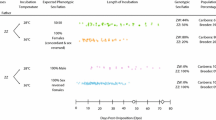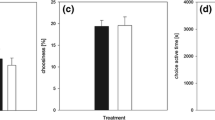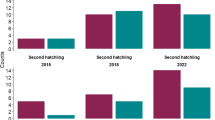Abstract
The concentration of yolk steroids was suggested to influence offspring gender in oviparous animals subject to both temperature-dependent sex determination (TSD) and genotypic sex determination (GSD). However, the proposed mechanisms of steroid effects are thought to differ between TSD and GSD: a direct effect of oestrogens on gonad feminisation in TSD species vs a differential induction of male-producing or female-producing gametes in GSD species. Geckos offer an ideal opportunity for testing these suggested mechanisms. Closely related gecko species differ in their modes of sex determination. They lay clutches of two synchronously formed eggs; both eggs share equal steroid levels. If identical hormonal composition and environment during vitellogenesis, gravidity and incubation determine the sex of the progeny, siblings should share the same gender in both TSD and GSD geckos. We found strong support for this prediction in a TSD gecko species. Among clutches that were incubated at the temperature that produced both sexes, there were no clutches with siblings of the opposite sex. On the other hand, about half of the clutches yielded siblings of the opposite sex in four GSD species. These results suggest that sex-determining systems constrain the ability of the female to produce single-sex siblings and, hence, it seems that the GSD mechanism constrains the opportunities for sex ratio manipulation in geckos via yolk steroid manipulation.
Similar content being viewed by others
References
Adkins-Regan E, Ottinger MA, Park J (1995) Maternal transfer of estradion to yolk alters sexual differentiation of avian offspring. J Exp Zool 271:466–470
Blumberg MS, Lewis SJ, Sokoloff G (2002) Incubation temperature modulates post-hatching thermoregulatory behavior in the Madagascar ground gecko Paroedura pictus. J Exp Biol 205:2777–2784
Bowden RM, Ewert MA, Nelson CE (2000) Environmental sex determination in a reptile varies seasonally and with yolk hormones. Proc R Soc Lond B 267:1745–1749
Bragg WK, Fawcett TB, Bragg TB, Viets BE (2000) Nest-site selection in two eublepharid gecko species with temperature-dependent sex determination and one with genotypic sex determination. Biol J Linn Soc 69:319–332
Bull JJ, Gutzke WHN, Bulmer MG (1988) Nest choice in a captive lizard with temperature-dependent sex determination. J Evol Biol 2:177–184
Conley AJ, Elf PK, Corbin CJ, Dubowsky S, Fivizzani A, Lang JW (1997) Yolk steroid decline during sexual differentiation in the alligator. Gen Comp Endocrinol 107:191–200
Conover DO (1984) Adaptive significance of temperature-dependent sex determination in a fish. Am Nat 123:297–313
Davis LM, Glenn TC, Elsey RM, Dessauer HC, Sawyer RH (2001) Multiple paternity and mating patterns in the American alligator, Alligator mississippiensis. Mol Ecol 10:1011–1024
Dodd KL, Murdock C, Wibbels T (2006) Interclutch variation in sex ratios produced at pivotal temperature in the red-eared slider, a turtle with temperature-dependent sex determination. J Herpetol 40:544–549
Elf PK (2003) Yolk steroid hormones and sex determination in reptiles with TSD. Gen Comp Endocrinol 132:349–355
Elf PK (2004) Yolk steroid hormones and their possible roles in TSD species. In: Valenzuela N, Lance V (eds) Temperature-dependent sex determination in vertebrates. Smithsonian Books, Washington, DC, pp 111–118
Elf PK, Lang JW, Fivizzani AJ (2002) Yolk hormone levels in the eggs of snapping turtles and painted turtles. Gen Comp Endocrinol 127:26–33
Ewen JG, Cassey P, Moller AP (2004) Facultative primary sex ratio variation: a lack of evidence in birds? Proc R Soc Lond B 271:1277–1282
Ewert MA, Nelson CE (2003) Metabolic heating of embryos and sex determination in the american alligator, Alligator mississippiensis. J Thermal Biol 28:159–165
Janes DE, Wayne ML (2006) Evidence for a genotype x environment interaction in sex-determining response to incubation temperature in the leopard gecko, Eublepharis macularius. Herpetologica 62:56–62
Janzen FJ, Krenz JG (2004) Phylogenetics: Which was first, TSD or GSD? In: Valenzuela N, Lance V (eds) Temperature-dependent sex determination in vertebrates. Smithsonian Books, Washington, DC, pp 121–130
Janzen FJ, Wilson ME, Tucker JK, Ford SP (2002) Experimental manipulation of steroid concentrations in circulation and in egg yolks of turtles. J Exp Zool 293:58–66
Kluge AG (1987) Cladistic relationships in the Gekkonoidea (Squamata, Sauria). Miscellaneous Publications of the Museum of Zoology, University of Michigan 173:1–54
Krackow S (2002) Why parental sex ratio manipulation is rare in higher vertebrates. Ethology 108:1041–1056
Kratochvíl L, Frynta D (2002) Body size, male combat and the evolution of sexual dimorphism in eublepharid geckos (Squamata: Eublepharidae). Biol J Linn Soc 76:303–314
Kratochvíl L, Frynta D (2006a) Body size effect on egg size in eublepharid geckos (Squamata: Eublepharidae), lizards with invariant clutch size: the negative allometry for egg size in ectotherms is not universal. Biol J Linn Soc 88:527–532
Kratochvíl L, Frynta D (2006b). Egg shape and size allometry in geckos (Squamata: Gekkota), lizards with contrasting eggshell structure: why to lay spherical eggs? J Zool Syst Evol Res 44:217–222
Kratochvíl L, Kubička L, Landová E (2006). Yolk hormone levels in the synchronously developing eggs of Paroedura picta, a gecko with genetic sex determination. Can J Zool 84:1683–1687
Kratochvíl L, Kubička L (2007). Why reduce clutch size to one or two eggs? Reproductive allometries reveal different evolutionary causes of invariant clutch size in lizards. Funct Ecol 21:171–177
Lang JW, Andrews HV (1994) Temperature-dependent sex determination in crocodilians. J Exp Zool 270:28–44
Le Galliard JF, Fitze PS, Cote J, Massot M, Clobert J (2005) Female common lizards (Lacerta vivipara) do not adjust their sex-biased investment in relation to the adult sex ratio. J Evol Biol 18:1455–1463
Lovern MB, Wade J (2003a) Yolk testosterone varies with sex in eggs of the lizard, Anolis carolinensis. J Exp Zool 295A:206–210
Lovern MB, Wade J (2003b) Sex steroids in green anoles (Anolis carolinensis): uncoupled maternal plasma and yolking follicle concentrations, potential embryonic steroidogenesis, and evolutionary implications. Gen Comp Endocrinol 134:109–115
Moritz C (1990) Patterns and processes of sex chromosome evolution in Gekkonid lizards (Sauria: Reptilia). In: Olmo E (ed) Cytogenetics of amphibians and reptiles. Birkhauser, Berlin, pp 205–219
Pearse DE, Janzen FJ, Avise JC (2002) Multiple paternity, sperm storage, and reproductive success of female and male painted turtles (Chrysemys picta) in nature. Behav Ecol Sociobiol 51:164–171
Petrie M, Schwabl H, Brande-Lavridsen N, Burke T (2001) Sex differences in avian yolk hormone levels. Nature 412:498
Pieau C, Dorizzi M (2004) Oestrogens and temperature-dependent sex determination in reptiles: all is in gonads. J Endocrinol 181:367–377
Pike TW, Petrie M (2003) Potential mechanisms of avian sex manipulation. Biol Rev 78:553–574
Pilz KM, Adkins-Regan E, Schwabl H (2005) No sex difference in yolk steroid concentrations of avian eggs at laying. Biol Lett 1:318–321
Radder R, Ali S, Shine R (2007) Offspring sex is not related to maternal allocation of yolk steroids in the lizard Bassiana duperreyi (Scincidae). Physiol Biochem Zool 80:220–227
Rhen T, Lang JW (1998) Among-family variation for environmental sex determination in reptiles. Evolution 52:1514–1520
Rhen T, Sakata JT, Zeller M, Crews D (2000) Sex steroid levels across the reproductive cycle of female leopard geckos, Eublepharis macularius, from different incubation temperatures. Gen Comp Endocrinol 118:322–331
Rhen T, Crews D, Fivizzani A, Elf P (2006) Reproductive tradeoffs and yolk steroids in female leopard geckos, Eublepharis macularius. J Evol Biol 19:1819–1829
Sarre SD, Georges A, Quinn A (2004) The ends of a continuum: genetic and temperature-dependent sex determination in reptiles. Bioessays 26:639–645
Silk JB, Willoughby E, Brown GR (2005) Maternal rank and local resource competition do not predict birth sex ratios in wild baboons. Proc R Soc Lond B 272:859–864
St. Juliana JR, Bowden RM, Janzen FJ (2004) The impact of behavioral and physiological maternal efects on offspring sex ratio in the common snapping turtle, Chelydra serpentina. Behav Ecol Sociobiol 56:270–278
Trivers RT, Willard DE (1973) Natural selection of parental ability to vary the sex ratio of offspring. Science 179:90–92
Valenzuela N, Adams DC, Janzen FJ (2003) Pattern does not equal process: Exactly when is sex environmentally determined? Am Nat 161:676–683
Viets BE, Tousignant A, Ewert MC, Nelson CE, Crews D (1993) Temperature-dependent sex determination in the leopard gecko, Eublepharis macularius. J Exp Zool 265:679–683
Viets BE, Ewert MA, Talent LG, Nelson CE (1994) Sex determining mechanisms in squamate reptiles. J Exp Zool 270:45–56
Warner DA, Shine R (2005) The adaptive significance of temperature-dependent sex determination: experimental tests with a short-lived lizard. Evolution 59:2209–2221
West SA, Sheldon BC (2002) Constraints in the evolution of sex ratio adjustment. Science 295:1685–1688
West SA, Shuker DM, Sheldon BC (2005) Sex-ratio adjustment when relatives interact: A test of constraints on adaptation. Evolution 59:1211–1228
Williams TD, Ames CE, Kiparissis Y, Wynne-Edwards KE (2005) Laying-sequence-specific variation in yolk oestrogen levels, and relationship to plasma oestrogen in female zebra finches (Taeniopygia guttata). Proc R Soc Lond B 272:173–177
Acknowledgements
We thank M. Pokorná, Z. Starostová, J. Červenka, Š. Gorički, F. J. Janzen, H. John-Alder and three anonymous referees for the critical reading of the manuscript and the constructive comments. J. Břehová, H. Jirků, M. Pokorná and K. Zelená assisted in animal care. This research was supported by GAAV project no. KJB611302; institutional support was provided by MSMT, project no. 0021620828. All work was performed in accordance with the regulations of the Institutional Animal Care and Use Committee of the Charles University.
Author information
Authors and Affiliations
Corresponding author
Rights and permissions
About this article
Cite this article
Kratochvíl, L., Kubička, L. & Landová, E. Does the mechanism of sex determination constrain the potential for sex manipulation? A test in geckos with contrasting sex-determining systems. Naturwissenschaften 95, 209–215 (2008). https://doi.org/10.1007/s00114-007-0317-0
Received:
Revised:
Accepted:
Published:
Issue Date:
DOI: https://doi.org/10.1007/s00114-007-0317-0




